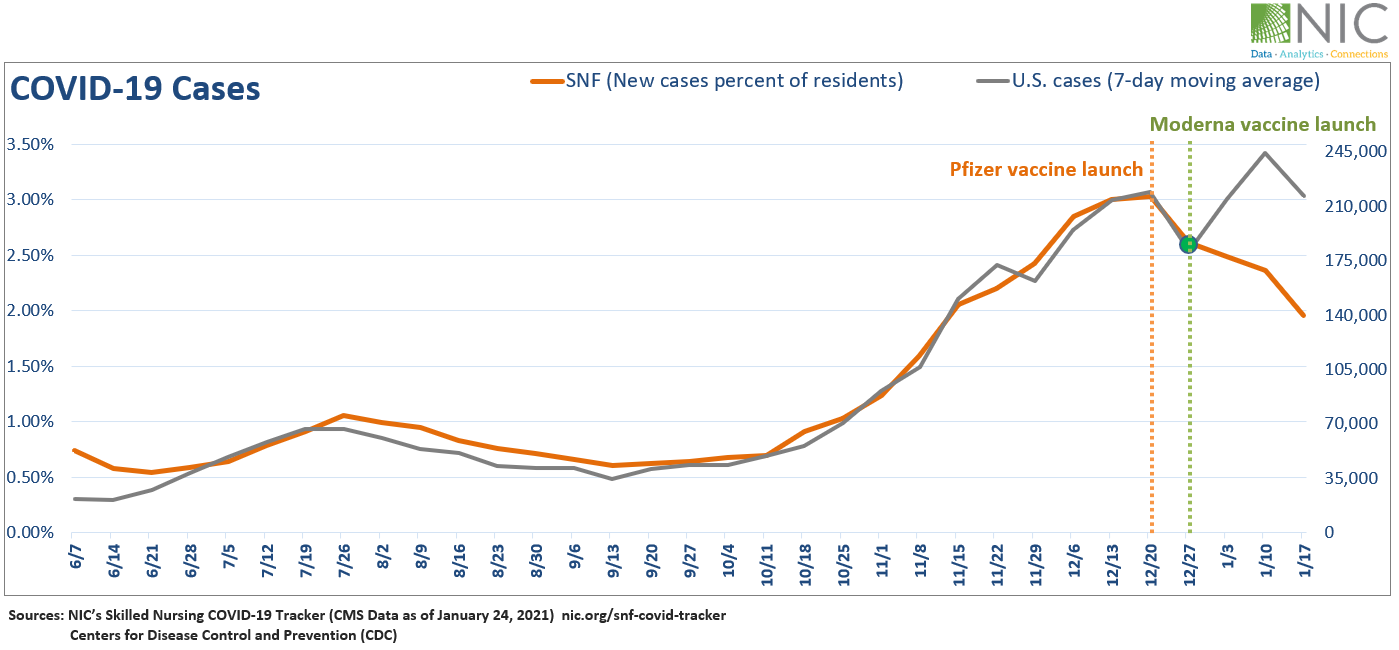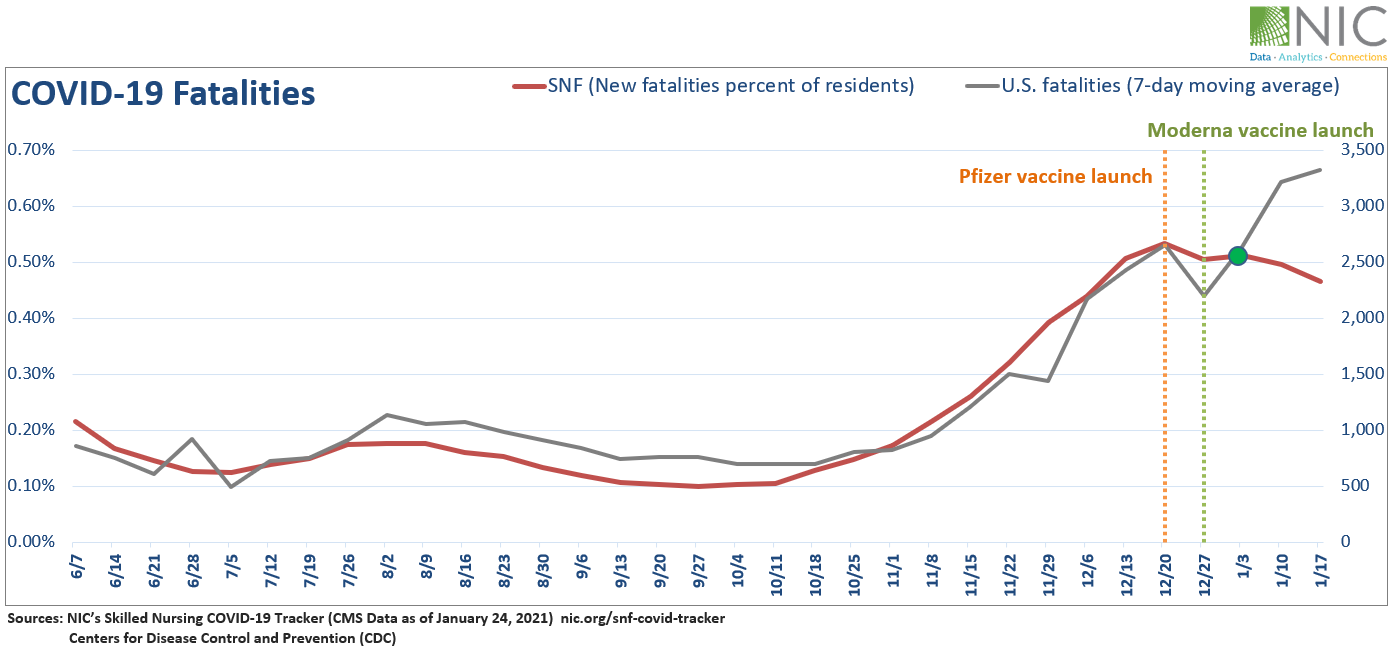Nursing homes have disproportionately suffered during the COVID-19 pandemic, housing some of those most vulnerable to the virus. Over the past year, the rate of new COVID-19 cases among skilled nursing residents moved nearly in tandem with the rate of new cases within the nation as a whole. However, the distribution and administration of vaccines looks to be having an impact on this susceptible population.
Within a few weeks of the launch of the Long Term Care (LTC) vaccination program administered through the Pharmacy Partnership Program, with the Pfizer-BioNTech vaccine on December 21, 2020 and the Moderna vaccine on December 28, new COVID-19 cases within skilled nursing properties have been sharply lower than the U.S overall new cases at any previous point. Various reports show that residents overwhelming opt in to receiving vaccinations, whereas during a similar time less than 10% of the U.S. population had received at least one vaccine shot. These initial results are promising and provide another potential data point on the effectiveness of vaccinations in preventing new COVID-19 cases.
As of February, over 30 million people have been inoculated in the U.S. and the vaccines appear to be safe and effective. According to the latest NIC Executive Survey Insights (Wave 20), which collected survey results from January 11 – 24, 2021, “two-thirds of residents (66%) and nearly one-half of staff (47%) have had their first dose.” Increasingly, there is support for the idea that as the number of people who are vaccinated increases, the number of hospitalizations should potentially decrease, as was indicated in a study of trends in Israel and its high vaccination rates.
Since CMS began reporting data in late May, newly confirmed cases within skilled nursing properties have followed the same pattern as the U.S. overall new cases, as reported by the CDC. For the week ending December 20, both overall new cases in the U.S. and within skilled nursing properties reached new peaks before slipping back in late December. In fact, U.S. new virus cases reached a seven-day moving average of about 220,000 on December 20, while the per-resident rate of new COVID-19 infections set a record at 3.03% at the same time, according to data compiled by NIC’s Skilled Nursing COVID Tracker.
However, in recent weeks, there has been a noticeable divergence in these trends as the vaccines have been administered and distributed to skilled nursing properties. NIC’s Skilled Nursing COVID Tracker featuring the latest CMS data update as of January 24, 2021 shows that case counts of COVID-19 and fatalities at skilled nursing properties have started to decline. Although, new cases in the U.S. (7-day moving average) reached levels higher than the prior December peaks by January 10 (244,702), newly confirmed cases within skilled nursing properties continued falling steadily and remained far below the previous peak seen on December 20, with a one percentage point decline recorded over four weeks from 3.03% on December 20 to 1.96% on January 17.

Similarly, new coronavirus fatalities among skilled nursing residents have flattened and slightly decreased from December 20 levels, while U.S new fatalities (7-day moving average) continued to climb at a faster pace. For the week ending December 20, fatalities in skilled nursing properties accounted for approximately 31% of overall new fatalities in the U.S. By January 17, the skilled nursing new fatalities as a share of total fatalities in the U.S. dropped to 21%.

“It’s only through having access to representative data that we can begin to understand the impact of policies and actions. The transparency provided by the CMS data set is helpful in understanding the impact prioritizing skilled nursing has had since it provides for a longitudinal view of the impact COVID-19 has had relative to the broader U.S. The decrease in new cases and fatalities in skilled nursing properties relative to trends in the total U.S. is encouraging, particularly given the timing relative to widespread distribution of the vaccine to long term care properties,” said NIC president and CEO, Brian Jurutka.
As background, NIC has been publishing a regular updated weekly surveillance report since June 2020 on the incidence of COVID-19 cases and fatalities among residents in the nation’s nursing care properties. Using data collected and reported by the Centers for Medicare & Medicaid Services (CMS), NIC’s Skilled Nursing COVID-19 Tracker (Tracker) reports CMS nursing home data and provides insights into the rate of virus spread within skilled nursing properties.
The Tracker shows where cases are spreading, slowing, or remaining flat. In addition, the Tracker depicts the incremental week-over-week change rate in four important metrics on a same-store basis, i.e. the same nursing properties are tracked each week across regions, sub-regions, states, and counties. The metrics include: (1) new COVID-19 confirmed cases per same store properties, (2) new COVID-19 confirmed cases as a share of residents, (3) new COVID-19 fatalities as a share of residents, and (4) occupancy rates (based on CMS Data). Importantly, the Tracker allows users to drill down to a smaller market or a specific property and access the underlying data.
To gain in-depth insights and track the week-over-week change rate for new resident cases and fatalities of COVID-19 within skilled nursing properties at the state and county levels, visit NIC.org. You can also access the Skilled Nursing COVID-19 Tracker along with a rich trove of analysis and insight on the NIC COVID-19 Resource Center.
For more reading on the effects of COVID-19 in skilled nursing properties, see the following report:
https://www.nic.org/wp-content/uploads/pdf/SNCT-Insights-Report-Special-Issue.pdf
NIC is committed to provide timely data, analyses and insights that increase transparency and understanding of the sector, especially in this difficult time of COVID-19. We strongly support all actions and efforts that prioritize distribution of COVID-19 vaccines, testing, and availability of PPE to protect frontline workers and residents.